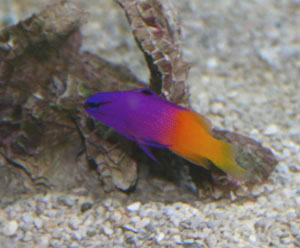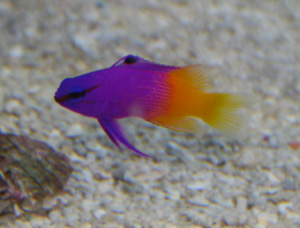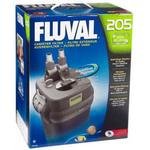|
|
Royal Gramma – Gramma loreto
The royal gramma comes from the tropical western Atlantic ocean including the Caribbean. They are a hardy fish and are good fish for the beginner. The tank setup should include an ultraviolet sterilizer in the filtration  system since these fish are susceptible to whitespot. system since these fish are susceptible to whitespot.
Maximum Size: The royal gramma should grow to a maximum size of 3.0 inches
Minimum Tank Size: The minimum tank size should be 35 gallons
Care Level: The royal gramma is a very hardy fish to maintain. On a scale of 1 –10, (10 being easy) it would rate a “9”. The tank should already be cycled before introducing this fish.
Tank Conditions: Temperature 77-79°F; Specific gravity: 1.021 – 1.024; pH: 8.1 – 8.3; Nitrates should be no more than 20 ppm.
Color: The royal gramma – as picture shows has two colors. The upper body is violet/purple and its back is bright yellow. For a small fish, there is a lot of color.
 Temperament: This is a good fish. It can ultimately become aggressive to other grammas of its kind. It is generally not aggressive. More than one can maintained, however, decorate the tank with plenty of live rock layered with plenty of nooks for hiding. A gramma may aggressively defend its spot is the tank. Temperament: This is a good fish. It can ultimately become aggressive to other grammas of its kind. It is generally not aggressive. More than one can maintained, however, decorate the tank with plenty of live rock layered with plenty of nooks for hiding. A gramma may aggressively defend its spot is the tank.
Reef Compatible: Will do well in a reef aquarium although it may eat small crustaceans and marine worms. It is generally a safe reef fish.
Diet: The royal gramma is an basically a plankton eater but will eat mostly brine-shrimp, fish meat crab meat, etc. Feed dried and frozen fish food.
Habitat: Provide with plenty of hiding places. Good water circulation is important as well as high quality water maintenance. Filtration should include a protein skimmer and activated carbon filtration.
Lighting: Depending on the tank setup you desire. The royal gramma needs no special setup
Compatibility: Gramma in general can be kept with, catfish, filefish, firefish, gobies, rabbitfish, butterflyfish, damselfish, clownfish to name a few and they should not be housed with groupers, sharks, lionfish or rays and can be a problem if housed with angelfish, cardinalfish, certain wrasses and triggerfish.
|
|
|
|




 system since these fish are susceptible to whitespot.
system since these fish are susceptible to whitespot. Temperament: This is a good fish. It can ultimately become aggressive to other grammas of its kind. It is generally not aggressive. More than one can maintained, however, decorate the tank with plenty of live rock layered with plenty of nooks for hiding. A gramma may aggressively defend its spot is the tank.
Temperament: This is a good fish. It can ultimately become aggressive to other grammas of its kind. It is generally not aggressive. More than one can maintained, however, decorate the tank with plenty of live rock layered with plenty of nooks for hiding. A gramma may aggressively defend its spot is the tank.